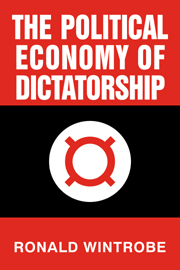Book contents
- Frontmatter
- Contents
- Dedication
- Acknowledgments
- Part I Introduction
- Part II Equilibrium political repression
- Part III Economics of autocracy
- 6 The economy of dictatorship
- 7 Redistribution and rent-seeking
- 8 Apartheid
- 9 The bureaucratic economy I: the model
- 10 The bureaucratic economy II: rise and fall
- Part IV The dynamics of dictatorship
- Part V Conclusion
- References
- Name index
- Subject index
10 - The bureaucratic economy II: rise and fall
Published online by Cambridge University Press: 05 June 2012
- Frontmatter
- Contents
- Dedication
- Acknowledgments
- Part I Introduction
- Part II Equilibrium political repression
- Part III Economics of autocracy
- 6 The economy of dictatorship
- 7 Redistribution and rent-seeking
- 8 Apartheid
- 9 The bureaucratic economy I: the model
- 10 The bureaucratic economy II: rise and fall
- Part IV The dynamics of dictatorship
- Part V Conclusion
- References
- Name index
- Subject index
Summary
The working of the system
We will now apply the model of the preceding chapter. The basic conception of the way the classic Soviet system is intended to work that will be advanced here is that the entire Soviet system of production may be likened to a giant bureaucracy. Within this bureaucracy the Communist party serves a function which is analogous to private property rights in a capitalist economy (insofar as it enforces trades). When the system functions as it is supposed to, subordinates within it compete with each other to advance the goals of their superiors by showing initiative, enterprise, dedication, and flexibility, just as they do within any successful large firm, government bureau, or other form of bureaucratic organization. Successful performance (not obedience to orders) is rewarded with (exchanged for) bonuses, more rapid promotion, and so forth, all of which are ultimately under the control of the Party in the classic Soviet system. The Party leadership sets the goals of the system, and through its vertical network, it ‘enforces’ trades which advance those goals. In this sense, commentators such as Alec Nove (1964) are correct in saying that ‘it is, most of all, the Party which, by its decisions at all levels, replaces the operation of economic forces’ (p. 61). But they are, in our way of thinking, wrong to conclude that this primacy of political decision is necessarily ‘inconsistent with economic rationality’ (p. 62).
- Type
- Chapter
- Information
- The Political Economy of Dictatorship , pp. 218 - 244Publisher: Cambridge University PressPrint publication year: 1998



